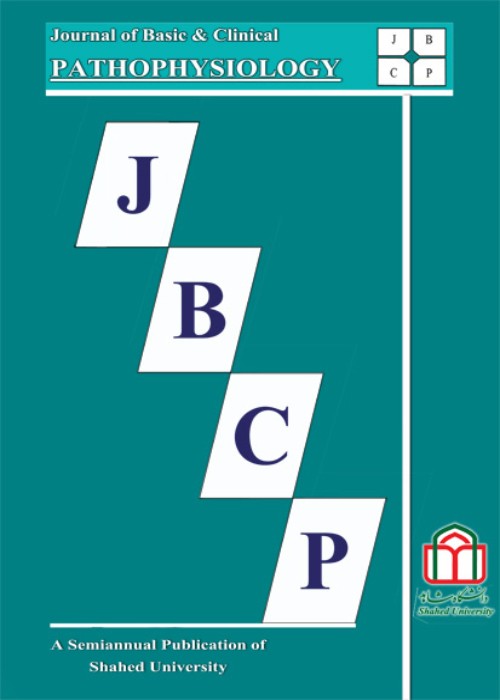The relationship between thyroid hormones and procalcitonin with neonatal sepsis: a case-control study in Iran in 2017
Author(s):
Article Type:
Research/Original Article (دارای رتبه معتبر)
Abstract:
Background and Objective
Neonatal sepsis (NS) is a major cause of mortality and morbidity in neonates. Correct and early diagnosis of NS can prevent its complications. The aim of this study was to investigate the relationship between the levels of thyroid hormones and procalcitonin (PCT) with NS. Materials and Methods
In this case-control study, 40 term neonates with proven NS diagnosis and 40 term neonates whose NS were rejected due to negative paraclinical findings were compared in terms of thyroid hormone levels, PCT and C reactive protein (CRP). Data were analyzed using SPSS v.17. Results
The most common clinical finding was fever in both groups, while there was no significant difference between the two groups (P = 0.1). The results of laboratory tests showed that the CRP levels in the NS group were significantly higher than the control group (P = 0.03). In terms of thyroid hormones, although TSH and T4 were higher in the NS group, this difference was not statistically significant (P = 0.94 and P = 0.22, respectively). In addition, PCT measurements and comparisons showed that this parameter was significantly higher in the NS group (P = 0.01). Conclusion
The results of this study demonstrated that CRP and PCT levels in NS neonates were significantly higher than non-NS neonates, while there was no significant difference in the level of thyroid hormones in the two groups. Further studies are recommended in this area. Background and Objective
Neonatal sepsis (NS) is a major cause of mortality and morbidity in neonates. Correct and early diagnosis of NS can prevent its complications. The aim of this study was to investigate the relationship between the levels of thyroid hormones and procalcitonin (PCT) with NS. Materials and Methods
In this case-control study, 40 term neonates with proven NS diagnosis and 40 term neonates whose NS were rejected due to negative paraclinical findings were compared in terms of thyroid hormone levels, PCT and C reactive protein (CRP). Data were analyzed using SPSS v.17. Results
The most common clinical finding was fever in both groups, while there was no significant difference between the two groups (P = 0.1). The results of laboratory tests showed that the CRP levels in the NS group were significantly higher than the control group (P = 0.03). In terms of thyroid hormones, although TSH and T4 were higher in the NS group, this difference was not statistically significant (P = 0.94 and P = 0.22, respectively). In addition, PCT measurements and comparisons showed that this parameter was significantly higher in the NS group (P = 0.01). Conclusion
The results of this study demonstrated that CRP and PCT levels in NS neonates were significantly higher than non-NS neonates, while there was no significant difference in the level of thyroid hormones in the two groups. Further studies are recommended in this area.Keywords:
Language:
English
Published:
Journal of Basic & Clinical Pathophysiology, Volume:7 Issue: 2, Summer-Autumn 2019
Pages:
1 to 5
magiran.com/p2067046
دانلود و مطالعه متن این مقاله با یکی از روشهای زیر امکان پذیر است:
اشتراک شخصی
با عضویت و پرداخت آنلاین حق اشتراک یکساله به مبلغ 1,390,000ريال میتوانید 70 عنوان مطلب دانلود کنید!
اشتراک سازمانی
به کتابخانه دانشگاه یا محل کار خود پیشنهاد کنید تا اشتراک سازمانی این پایگاه را برای دسترسی نامحدود همه کاربران به متن مطالب تهیه نمایند!
توجه!
- حق عضویت دریافتی صرف حمایت از نشریات عضو و نگهداری، تکمیل و توسعه مگیران میشود.
- پرداخت حق اشتراک و دانلود مقالات اجازه بازنشر آن در سایر رسانههای چاپی و دیجیتال را به کاربر نمیدهد.
دسترسی سراسری کاربران دانشگاه پیام نور!
اعضای هیئت علمی و دانشجویان دانشگاه پیام نور در سراسر کشور، در صورت ثبت نام با ایمیل دانشگاهی، تا پایان فروردین ماه 1403 به مقالات سایت دسترسی خواهند داشت!
In order to view content subscription is required
Personal subscription
Subscribe magiran.com for 70 € euros via PayPal and download 70 articles during a year.
Organization subscription
Please contact us to subscribe your university or library for unlimited access!


